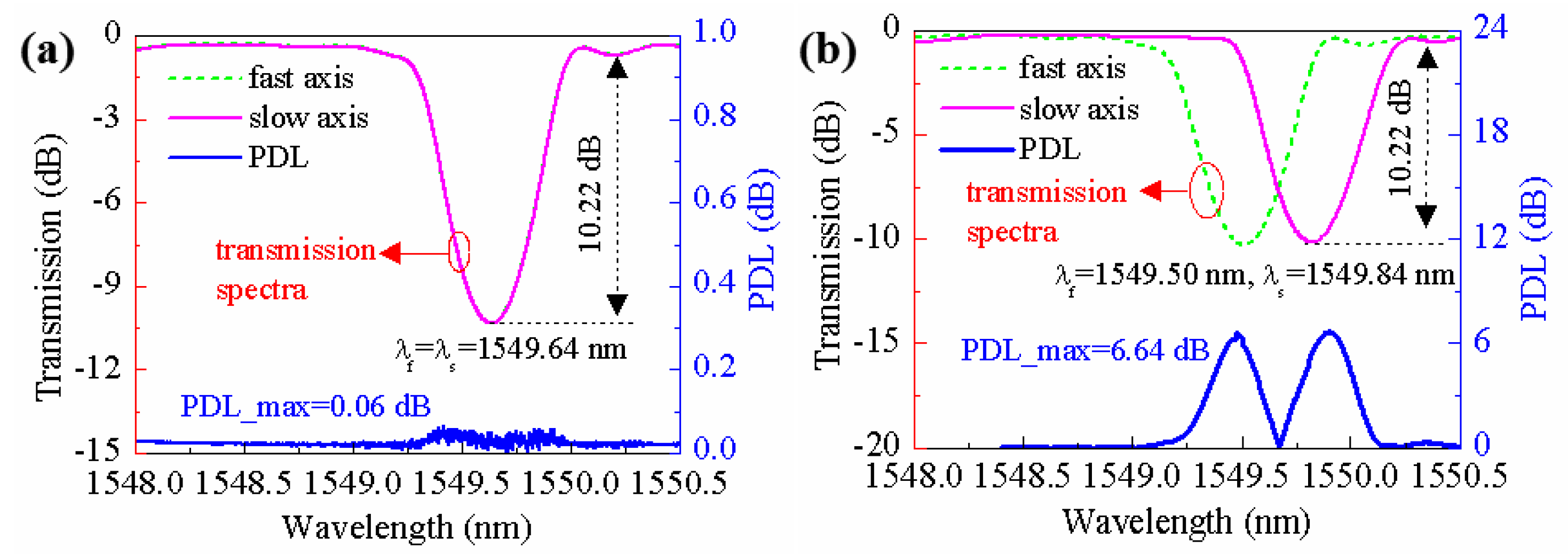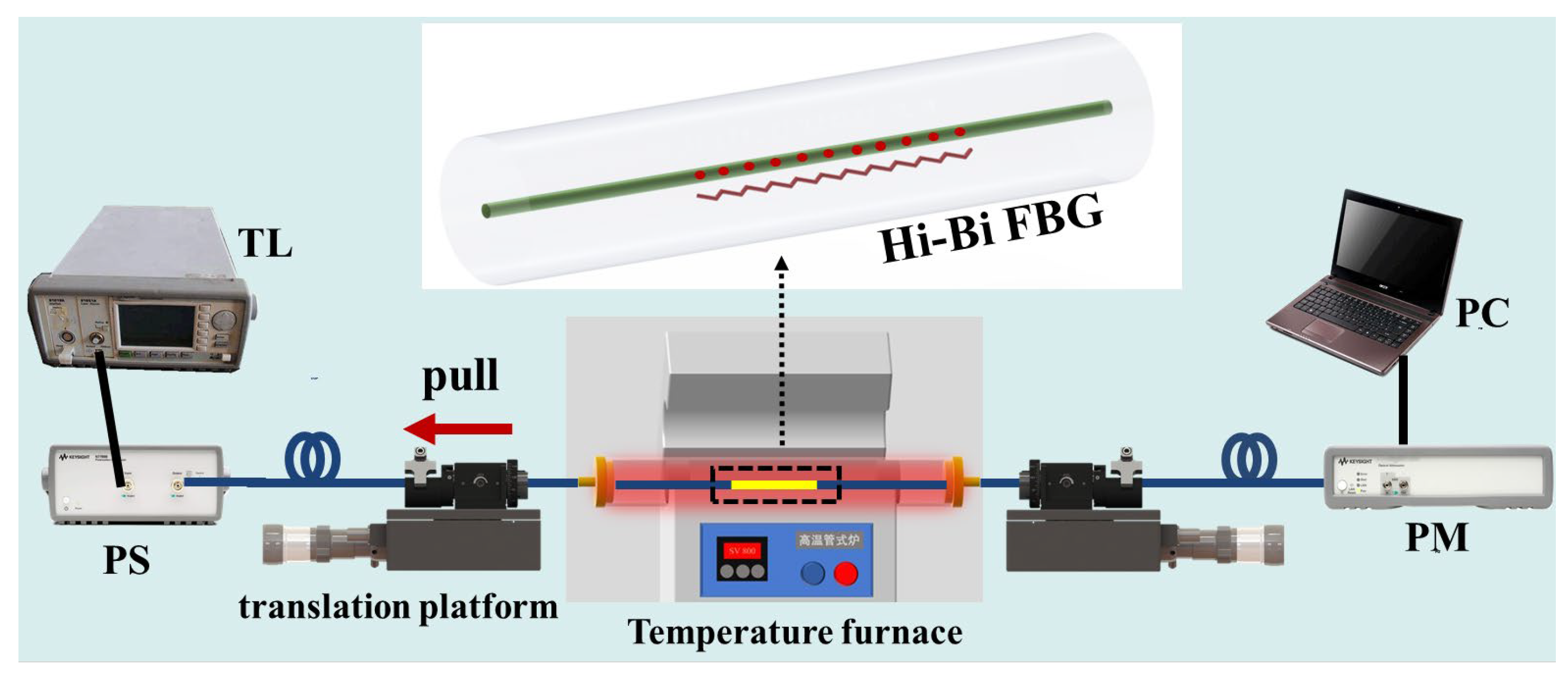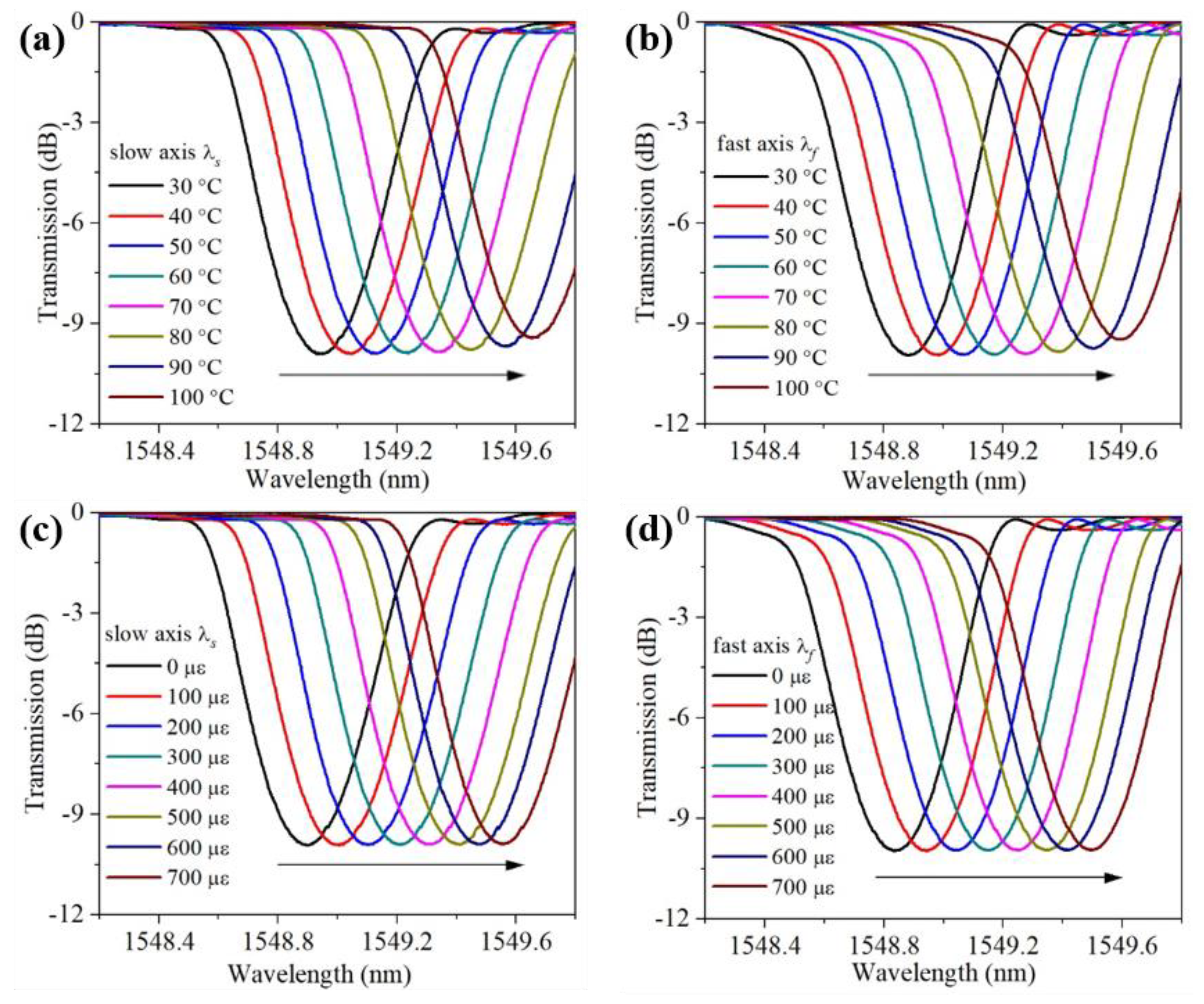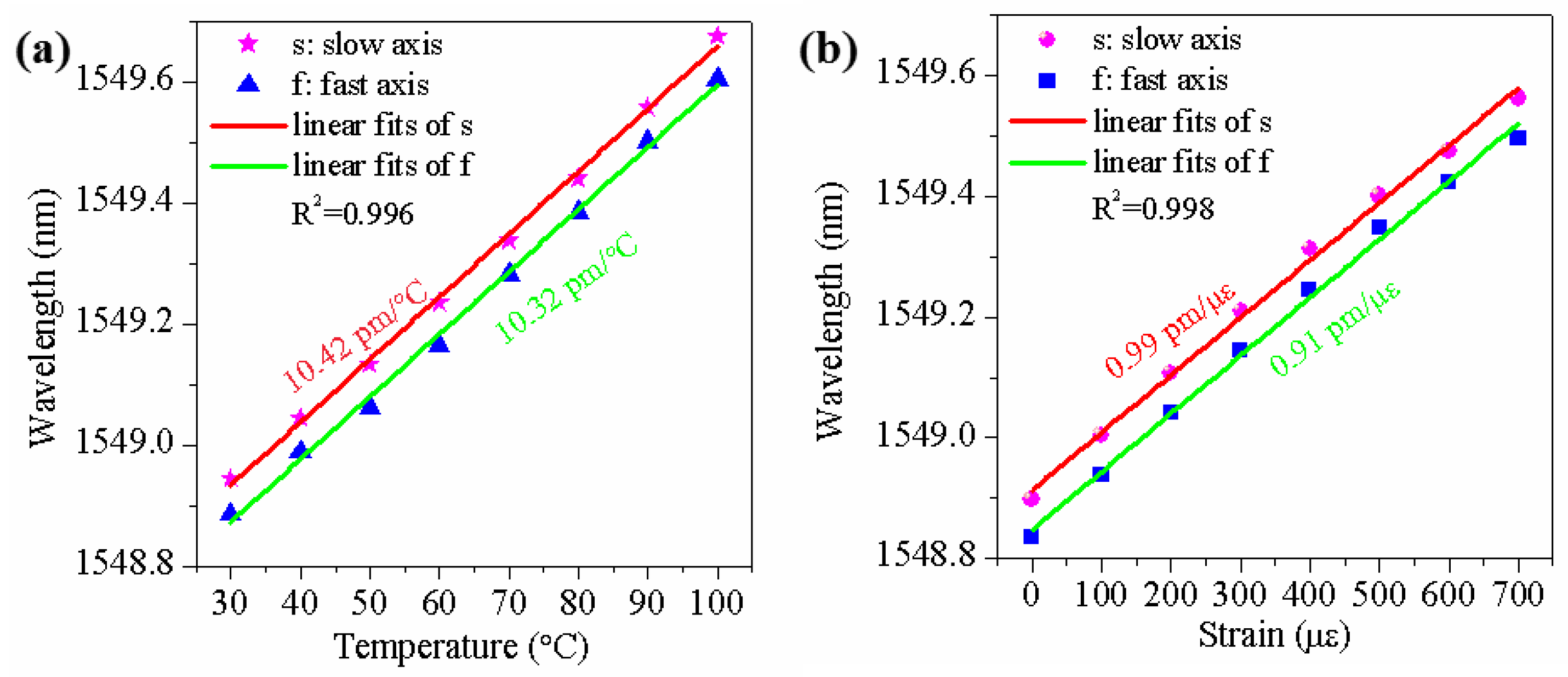Highly Birefringent FBG Based on Femtosecond Laser-Induced Cladding Stress Region for Temperature and Strain Decoupling
Abstract
1. Introduction
2. Sensing Principle of Hi-Bi FBG Sensor
3. Preparation of Hi-Bi FBG Sensor
4. Simultaneous Measurement of Temperature and Strain
5. Conclusions
Author Contributions
Funding
Institutional Review Board Statement
Informed Consent Statement
Data Availability Statement
Conflicts of Interest
References
- Rao, Y.J. In-fibre Bragg grating sensors. Meas. Sci. Technol. 1997, 8, 355. [Google Scholar] [CrossRef]
- Gan, W.; Li, X.; Wang, Y.; Wulamu, A.; Zhang, C.; Chen, X. Gas pipeline leakage detection and location by using w-FBG array based micro-strain sensing technology. Meas. Sci. Technol. 2024, 35, 056108. [Google Scholar] [CrossRef]
- Zhang, H.; Liu, T.; Lu, J.; Lin, R.; Chen, C.; He, Z.; Cui, S.; Liu, Z.; Wang, X.; Liu, B.; et al. Static and ultrasonic structural health monitoring of full-size aerospace multi-function capsule using FBG strain arrays and PSFBG acoustic emission sensors. Opt. Fiber Technol. 2023, 78, 103316. [Google Scholar] [CrossRef]
- Li, C.; Li, J.; Luo, C.; Xu, Q.; Wan, X.; Yang, L. Diagnosis and monitoring of tunnel lining defects by using comprehensive geophysical prospecting and fiber bragg grating strain sensor. Sensors 2024, 24, 1749. [Google Scholar] [CrossRef] [PubMed]
- Guo, J.; Zhao, K.; Zhou, B.; Ning, W.; Jiang, K.; Yang, C.; Kong, L.; Dai, Q. Wearable and skin-mountable fiber-optic strain sensors interrogated by a free-running, dual-comb fiber laser. Adv. Opt. Mater. 2019, 7, 1900086. [Google Scholar] [CrossRef]
- Ji, L.; Sun, Q.; Zhao, S.; Yang, S.; Xu, J.; Su, J.; Wu, C. High-resolution fiber grating pressure sensor with in-situ calibration for deep sea exploration. Opt. Express 2023, 31, 10358–10367. [Google Scholar] [CrossRef]
- Guo, K.; He, J.; Shao, L.; Xu, G.; Wang, Y. Simultaneous Measurement of Strain and Temperature by a Sawtooth Stressor-Assisted Highly Birefringent Fiber Bragg Grating. J. Light. Technol. 2020, 38, 2060–2066. [Google Scholar] [CrossRef]
- Su, D.; Qiao, X.; Chen, F.; Bao, W. Compact Dual Fiber Bragg Gratings for Simultaneous Strain and High-Temperature Measurement. IEEE Sens. J. 2019, 19, 5660–5664. [Google Scholar] [CrossRef]
- Wu, H.; Lin, Q.; Jiang, Z.; Zhang, F.; Li, L.; Zhao, L. A temperature and strain sensor based on a cascade of double fiber Bragg grating. Meas. Sci. Technol. 2019, 30, 065104. [Google Scholar] [CrossRef]
- Liang, J.; Yu, Y.; Bian, Q.; Xu, W.; Wang, Z.; Zhang, S.; Weng, J.; Zhu, J.; Chen, Y.; Hu, X.; et al. Metal-coated high-temperature strain optical fiber sensor based on cascaded air-bubble FPI-FBG structure. Opt. Express 2023, 31, 16795–16811. [Google Scholar] [CrossRef]
- Gao, X.; Ning, T.; Zhang, C.; Xu, J.; Zheng, J.; Lin, H.; Li, J.; Pei, L.; You, H. A dual-parameter fiber sensor based on few-mode fiber and fiber Bragg grating for strain and temperature sensing. Opt. Commun. 2020, 454, 124441. [Google Scholar] [CrossRef]
- Bian, Q.; Podhrazsky, A.; Bauer, C.; Stadler, A.; Buchfellner, F.; Kuttler, R.; Jakobi, M.; Volk, W.; Koch, A.W.; Roths, J. Temperature and external strain sensing with metal-embedded optical fiber sensors for structural health monitoring. Opt. Express 2022, 30, 33449–33464. [Google Scholar] [CrossRef]
- Zhu, M.; Murayama, H.; Wada, D.; Kageyama, K. Dependence of measurement accuracy on the birefringence of PANDA fiber Bragg gratings in distributed simultaneous strain and temperature sensing. Opt. Express 2017, 25, 4000–4017. [Google Scholar] [CrossRef] [PubMed]
- Tian, Q.; Xin, G.; Lim, K.; He, Y.; Liu, J.; Ahmad, H.; Liu, X.; Yang, H. Cascaded Fabry-Perot interferometer-regenerated fiber Bragg grating structure for temperature-strain measurement under extreme temperature conditions. Opt. Express 2020, 28, 30478–30488. [Google Scholar] [CrossRef] [PubMed]
- Zhu, J.; He, W.; Li, S.; Li, Z.; Zhu, L. Temperature and strain simultaneous sensing measurement based on an all-fiber Mach-Zehnder interferometer and fiber Bragg grating. Appl. Opt. 2023, 62, 6661–6671. [Google Scholar] [CrossRef] [PubMed]
- Patrick, H.; Williams, G.; Kersey, A.; Pedrazzani, J.; Vengsarkar, A. Hybrid fiber Bragg grating/long period fiber grating sensor for strain/temperature discrimination. IEEE Photon. Technol. Lett. 1996, 8, 1223–1225. [Google Scholar] [CrossRef]
- James, S.; Dockney, M.; Tatam, R. Simultaneous independent temperature and strain measurement using in-fibre Bragg grating sensors. Electron. Lett. 1996, 32, 1133–1134. [Google Scholar] [CrossRef]
- Guan, B.O.; Tam, H.Y.; Chan, H.L.W.; Choy, C.L.; Demokan, M.S. Discrimination between strain and temperature with a single fiber Bragg grating. Microw. Opt. Technol. Lett. 2002, 33, 200–202. [Google Scholar] [CrossRef]
- Cavaleiro, P.; Araujo, F.; Ferreira, L.; Santos, J.; Farahi, F. Simultaneous measurement of strain and temperature using Bragg gratings written in germanosilicate and boron-codoped germanosilicate fibers. IEEE Photon. Technol. Lett. 1999, 11, 1635–1637. [Google Scholar] [CrossRef]
- Li, X.; Duan, T.; Wang, R.; Chen, F.; Qiao, X. Ultrahigh return loss LPFGs fabricated via femtosecond laser direct writing of ultrashort TFBGs. Opt. Lett. 2025, 50, 2053–2056. [Google Scholar] [CrossRef]
- Li, X.; Wang, J.; Chen, F.; Qiao, X. Femtosecond laser direct writing tilted fiber Bragg gratings in multicore fiber. Opt. Lett. 2024, 49, 6984–6987. [Google Scholar] [CrossRef] [PubMed]
- Zhao, R.; Lu, X.; Gao, C.; Ye, X.; Li, H.; Wu, B.; Wang, M. Highly localized FBG fabricated by femtosecond laser single-pulse filaments. Opt. Laser Technol. 2025, 187, 112810. [Google Scholar] [CrossRef]
- Gao, S.; Liu, Y.; Yang, J.; Duan, Z.; Yin, T. Ultrasensitive refractive sensor based on femtosecond laser inscribed long-period fiber grating with a few microcavities. J. Light. Technol. 2023, 42, 1696–1701. [Google Scholar] [CrossRef]
- Xiao, K.; Zan, Y.; Ouyang, Y.; Fei, S.; Hu, Z.; Fang, L.; Chen, Q. Low-loss and tight-bend waveguides via multiple scans of a femtosecond laser. Opt. Lett. 2025, 50, 1449–1452. [Google Scholar] [CrossRef]
- Guo, K.; He, J.; Li, H.; Xu, B.; Lu, S.; Liu, S.; Wang, Y. High-spatial-resolution high-temperature sensor based on ultra-short fiber Bragg gratings with dual-wavelength differential detection. J. Light. Technol. 2021, 40, 2166–2172. [Google Scholar] [CrossRef]
- Guo, K.; Yang, R.; Wang, H.; Zhou, F.; Chu, R.; Wang, H.; Liu, Y. Ultrashort Fiber Optic Temperature Sensor for the Small-Scale Heat Sources. IEEE Sens. J. 2023, 24, 2682–2688. [Google Scholar] [CrossRef]
- Zhu, Y.; Miao, Z.; Wu, Z.; Shi, C.; Deng, G.; Zhang, H.; Zhou, S. Thulium doped all-fiber laser based on a double-cladding Bragg grating via femtosecond laser plane-by-plane writing technology. Opt. Express 2025, 33, 2386–2394. [Google Scholar] [CrossRef]
- Xu, B.; He, J.; Xu, X.; He, J.; Guo, K.; Bao, W.; Wang, Y. Simultaneous measurement of torsion and strain at high temperature by using a highly birefringent cladding fiber Bragg grating. Opt. Express 2022, 30, 28710–28719. [Google Scholar] [CrossRef]
- Oh, S.; Han, W.; Paek, U.; Chung, Y. Discrimination of temperature and strain with a single FBG based on the birefringence effect. Opt. Express 2004, 12, 724–729. [Google Scholar] [CrossRef]
- Pashaie, R.; Mirzaei, A.; Vahedi, M.; Shokrieh, M. Discrimination between the strain and temperature effects of a cantilever beam using one uniform FBG sensor. Opt. Quant. Electron. 2023, 55, 114. [Google Scholar] [CrossRef]







| Parameter | Value |
|---|---|
| Core diameter | 10.0 ± 0.1 μm |
| Cladding diameter | 125.0 ± 0.5 μm |
| GeO₂ doping concentration in core | 3.2 mol% |
| Refractive Index (Core) | 1.468 |
| Fabrication Method | Sensor Structure | Fiber Type | Demodulation Method | B | Temperature Sensitivity | Strain Sensitivity |
|---|---|---|---|---|---|---|
| Fs laser direct writing technology [28] | Hi-Bi CFBG | SMF | OFDR | 2.8 × 10−4 | NA | 1.06 pm/μɛ |
| UV laser phase mask and fs laser direct writing [7] | FBG + stressor | SMF | Wavelength and wavelength difference demodulation | 2.96 × 10−4 | 9.57 pm/°C | 1.25 pm/μɛ |
| UV laser phase mask [29] | FBG | photosensitive SMF | Wavelength and PDL demodulation | 4 × 10−6 | 11 pm/°C | 1.11 pm/μɛ |
| UV laser phase mask [30] | uniform FBG | photosensitive SMF | Wavelength and FWHW demodulation | NA | 14.4 pm/°C | 0.84 pm/μɛ |
| UV laser phase mask [13] | Panda-FBG | PMF | OFDR | 8.87 × 10−4 | 12.07 pm/°C | 1.27 pm/μɛ |
| Fs laser direct writing technology in this work | FBG + stressor | SMF | Wavelength Demodulation | 2.97 × 10−4 | 10.42 pm/°C | 0.99 pm/μɛ |
Disclaimer/Publisher’s Note: The statements, opinions and data contained in all publications are solely those of the individual author(s) and contributor(s) and not of MDPI and/or the editor(s). MDPI and/or the editor(s) disclaim responsibility for any injury to people or property resulting from any ideas, methods, instructions or products referred to in the content. |
© 2025 by the authors. Licensee MDPI, Basel, Switzerland. This article is an open access article distributed under the terms and conditions of the Creative Commons Attribution (CC BY) license (https://creativecommons.org/licenses/by/4.0/).
Share and Cite
Guo, K.; Wu, H.; Liang, Y.; Su, M.; Wang, H.; Chu, R.; Zhou, F.; Liu, Y. Highly Birefringent FBG Based on Femtosecond Laser-Induced Cladding Stress Region for Temperature and Strain Decoupling. Photonics 2025, 12, 502. https://doi.org/10.3390/photonics12050502
Guo K, Wu H, Liang Y, Su M, Wang H, Chu R, Zhou F, Liu Y. Highly Birefringent FBG Based on Femtosecond Laser-Induced Cladding Stress Region for Temperature and Strain Decoupling. Photonics. 2025; 12(5):502. https://doi.org/10.3390/photonics12050502
Chicago/Turabian StyleGuo, Kuikui, Hao Wu, Yonghao Liang, Mingshen Su, Hongcheng Wang, Rang Chu, Fei Zhou, and Ye Liu. 2025. "Highly Birefringent FBG Based on Femtosecond Laser-Induced Cladding Stress Region for Temperature and Strain Decoupling" Photonics 12, no. 5: 502. https://doi.org/10.3390/photonics12050502
APA StyleGuo, K., Wu, H., Liang, Y., Su, M., Wang, H., Chu, R., Zhou, F., & Liu, Y. (2025). Highly Birefringent FBG Based on Femtosecond Laser-Induced Cladding Stress Region for Temperature and Strain Decoupling. Photonics, 12(5), 502. https://doi.org/10.3390/photonics12050502






